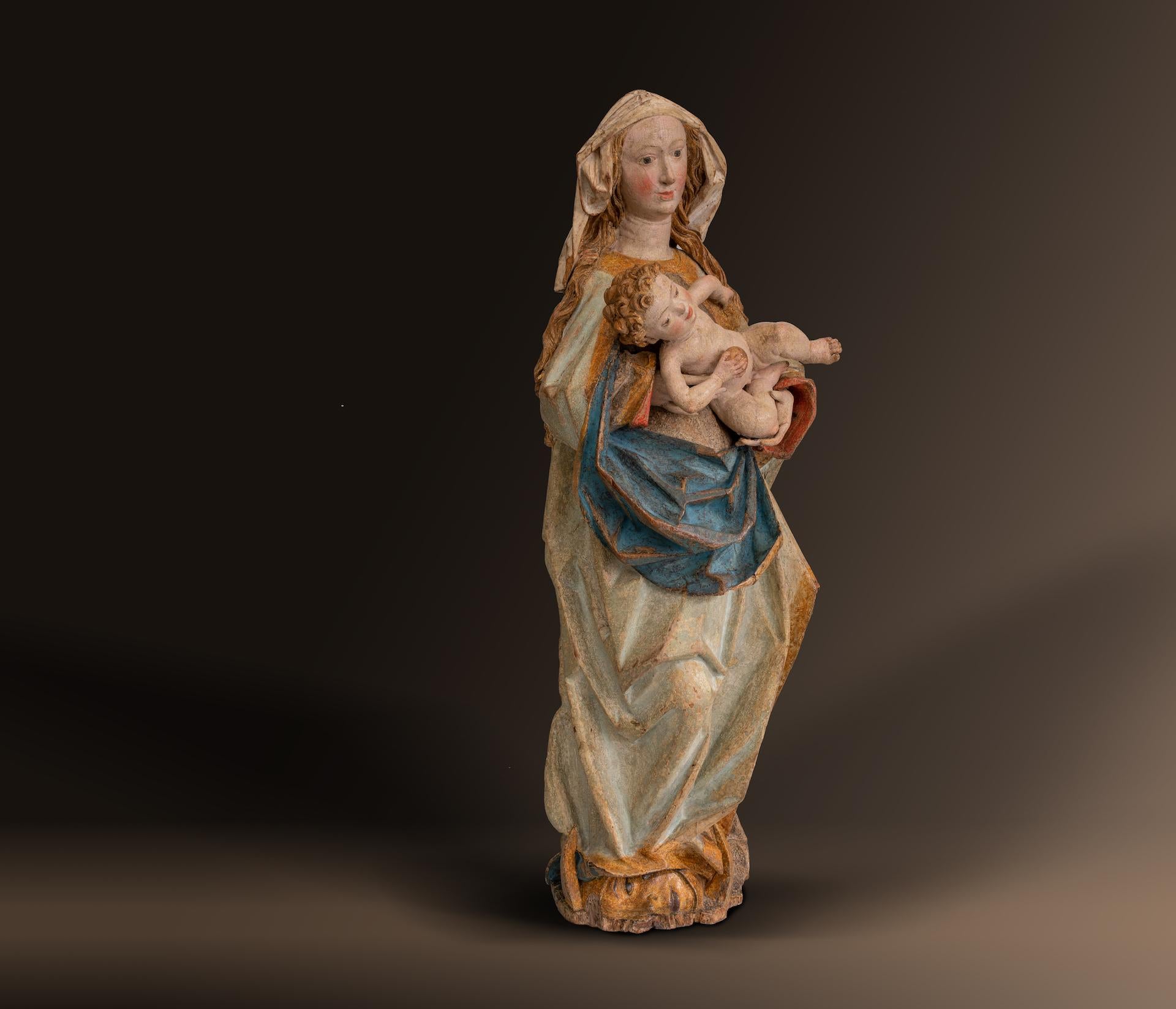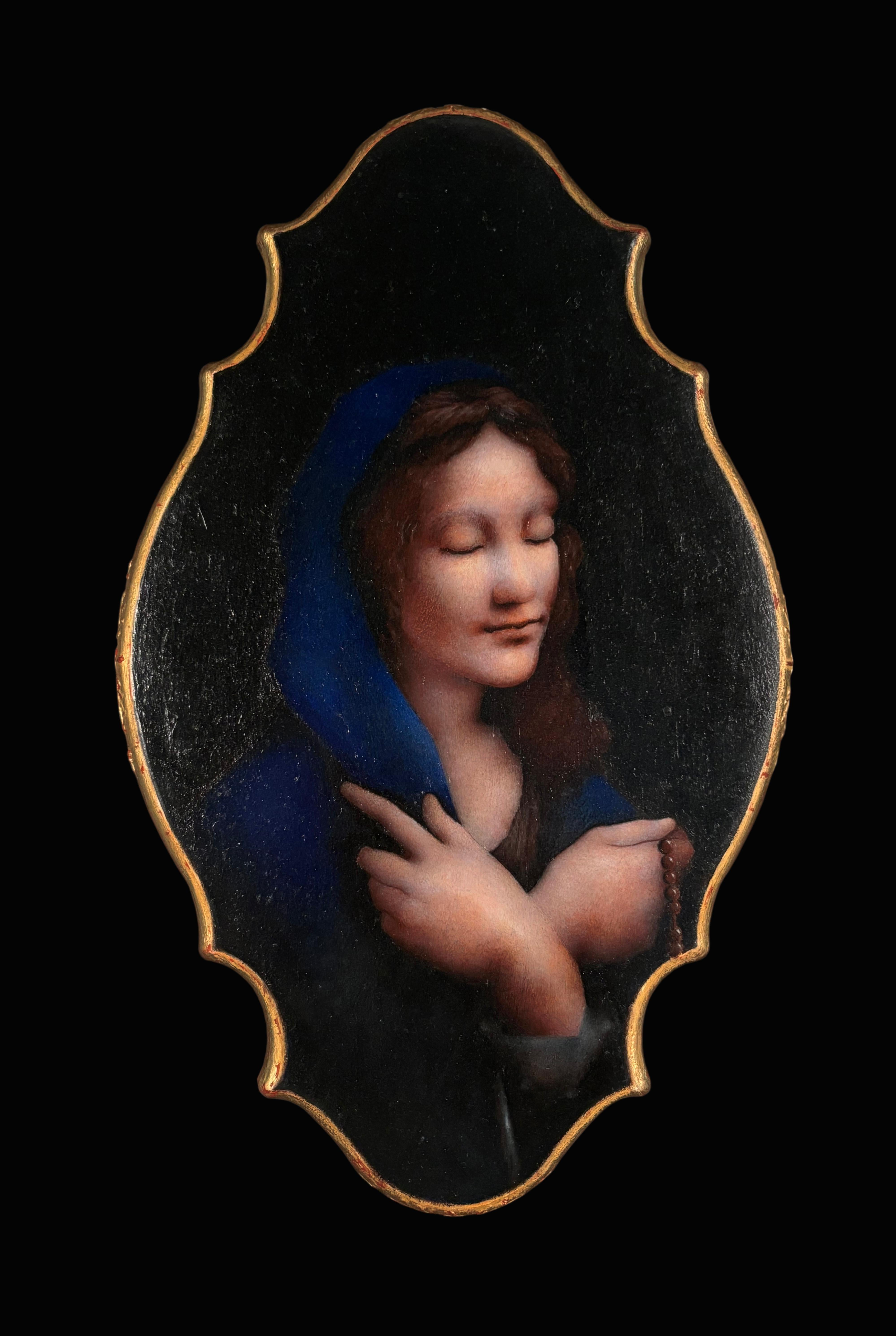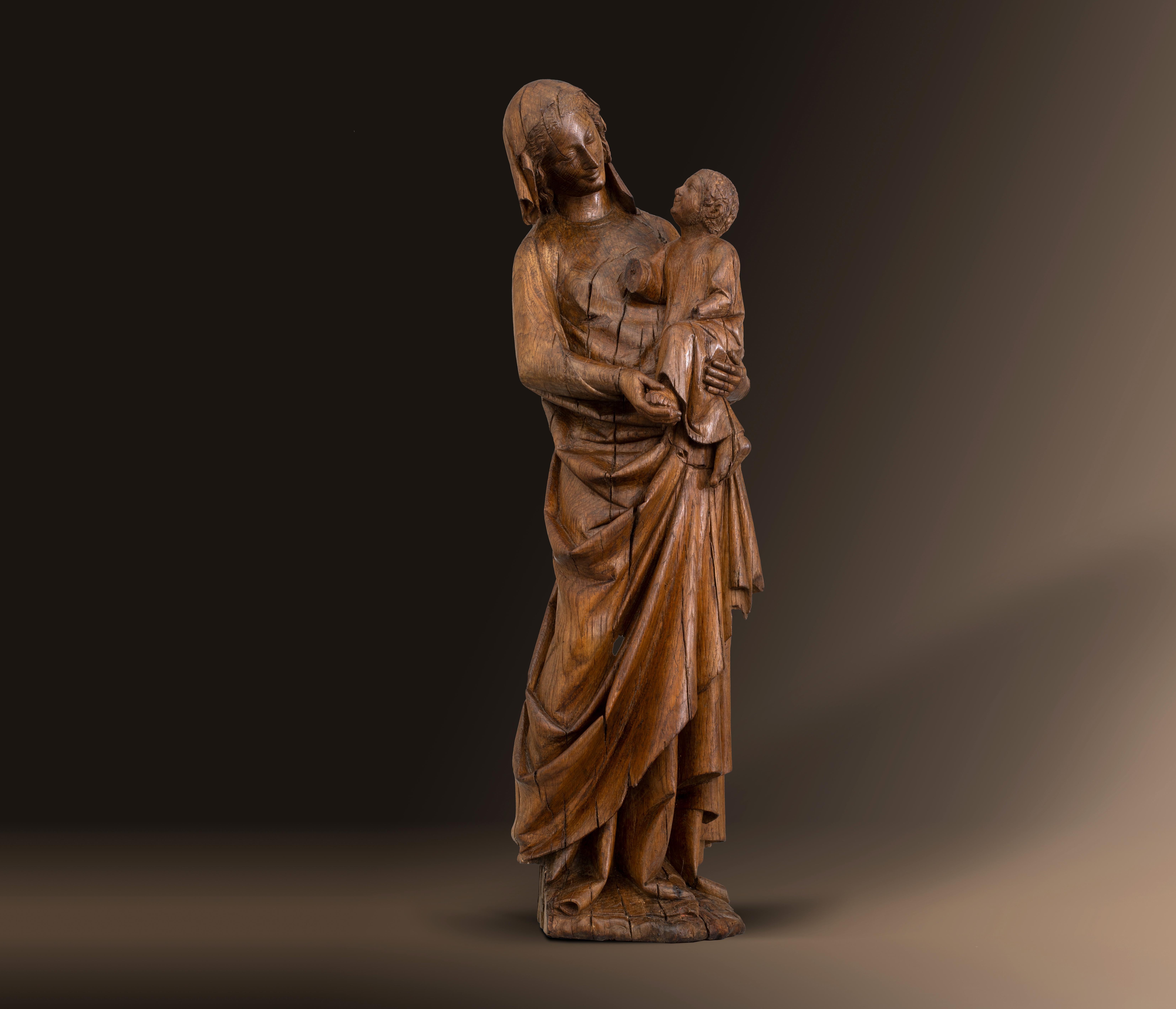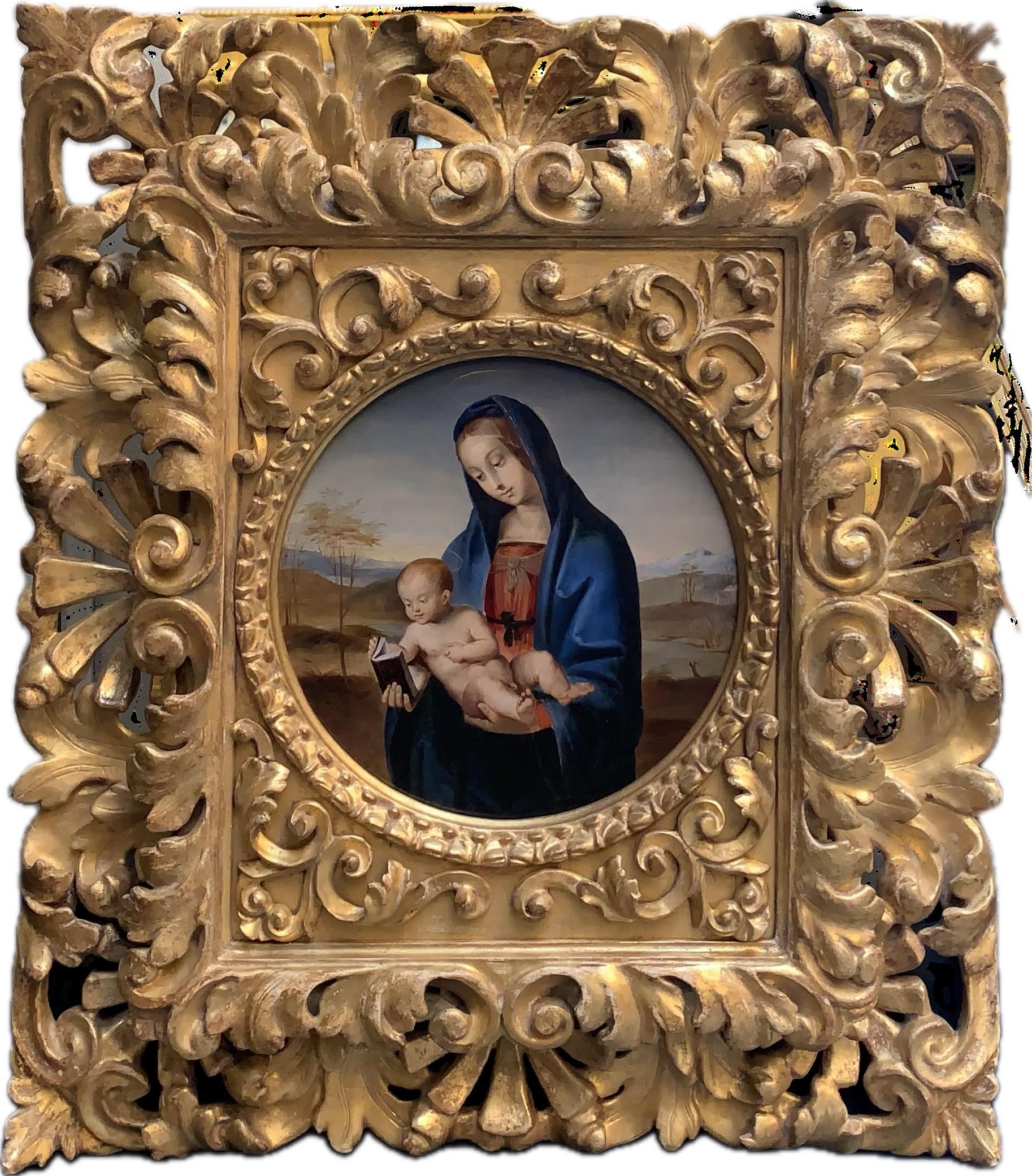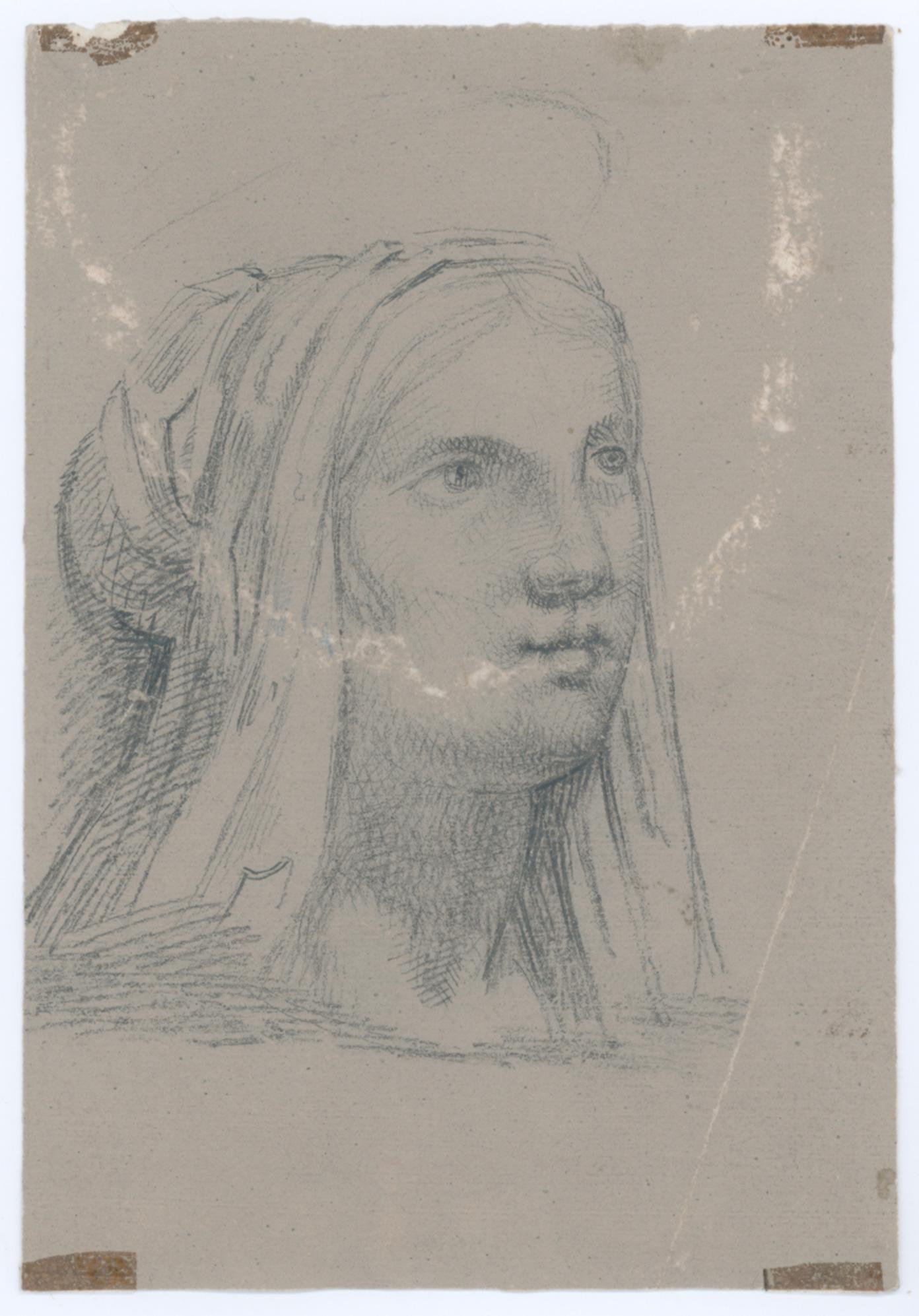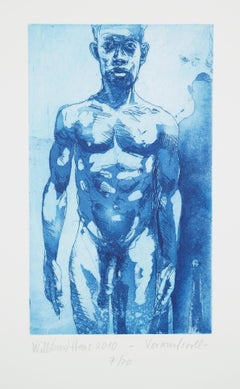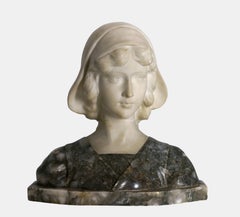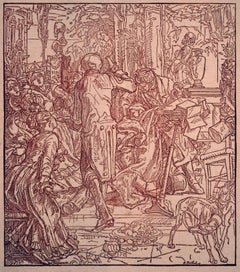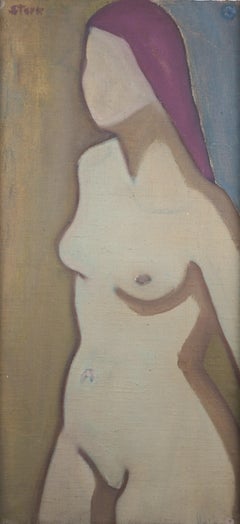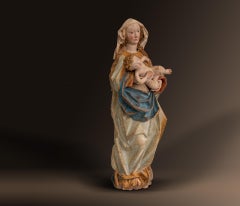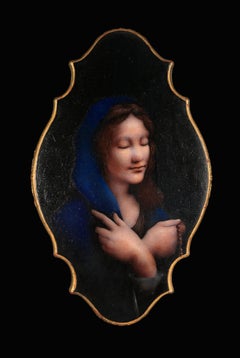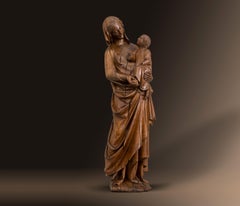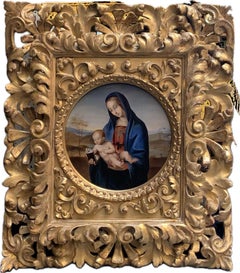Items Similar to Madonna del Dito - Heavenly beauty down to the fingertip -
Video Loading
Want more images or videos?
Request additional images or videos from the seller
1 of 7
UnknownMadonna del Dito - Heavenly beauty down to the fingertip -about 1880
about 1880
$3,608.45
$4,510.5620% Off
£2,722.81
£3,403.5120% Off
€3,040
€3,80020% Off
CA$5,029.35
CA$6,286.6920% Off
A$5,467.08
A$6,833.8420% Off
CHF 2,865.23
CHF 3,581.5420% Off
MX$66,538.96
MX$83,173.7120% Off
NOK 36,066.39
NOK 45,082.9920% Off
SEK 33,890.67
SEK 42,363.3420% Off
DKK 23,156.79
DKK 28,945.9920% Off
About the Item
KPM, Madonna del Dito, oval, slightly curved porcelain picture plate by KPM Berlin in fine polychrome onglaze painting, 27 x 22 cm (plate size), 33 x 28.5 cm (frame), unsigned, press mark from 1825, probably last third of the 19th century. Gold moulded wooden frame of the period.
- Minimal loss of paint to the margins, period frame somewhat rubbed and with a superficial hairline crack to the front.
About the artwork
The type of the Madonna del Dito (Madonna with the Finger) goes back to a painting by Carlo Dolci, now lost. Dolci painted it in the middle of the 17th century on copper, which gives the painting the character of fine enamel. This effect is enhanced by painting on porcelain. As if by soft-focus, Mary's lovely face appears almost transfigured, but at the same time it shows a precision that emphasises the delicacy of her features with sharp contours. Only porcelain painting can achieve the effect of melting softness with such precision, and here it has been achieved to perfection.
In an oval field, Mary appears dressed in a cobalt blue mantle against a dark brown background. The robe forms a kind of niche from which her face shines out. Her eyelids are half closed, suggesting that she is lost in thought. According to Luke, "But Mary kept all these words in her heart, and gave much thought to them" (Lk 2:19), meditating on the divine grace that had been bestowed on her, giving her beauty an unfathomable depth. As the chosen Mother of God, Mary's perfect beauty is at the same time a purity untainted by the Fall. She is the temple of God, which is itself holy, as the delicate halo around her head makes clear. The brown tone of the background, lightened to ochre, is echoed in the brown undergarment, under which Mary's finely drawn golden hair is visible.
The dominant blue, which adds to the depth, is also symbolic: it represents heaven and identifies Mary as the Queen of Heaven, crowned by the aura of a halo.
Her hands, clasped as if in prayer, are wrapped in the celestial robe, only the finger that gives the name to the picture peeps out from under the mantle, giving the Mother of God something human but also something divine, since she touches the celestial blue with her finger and influences it with her touch. An effective power that makes Mary a great intercessor.
Last but not least, the fingertip with the convincingly depicted fingernail is also an expression of the precision of the fine painting before the eye.
While painting on copper plates, which is comparable in its aesthetic effect, was widespread especially in the 17th and early 18th centuries, painting on porcelain had its heyday in the second half of the 19th century and was brought to perfection in the Königliche Porzellan-Manufaktur Berlin (KPM).
Thank you for your interest! I hope I have been able to explain to you the special character of the artwork. If you have any questions of any kind, please feel free to contact me.
I wish you many more discoveries in the realm of art,
Dr Martin Kirves
GERMAN VERSION
KPM, Madonna del Dito, ovale leicht gewölbte Porzellan-Bildplatte der KPM Berlin in feiner polychromer Aufglasurmalerei, 27 x 22 cm (Plattenmaß), 33 x 28,5 cm (Rahmen), unsigniert, Pressmarke ab 1825, wohl letztes Drittel des 19. Jh. Goldprofilierter Holzrahmen der Zeit.
- am Randbereich minimale Farbfehlstellen, Rahmen der Zeit etwas berieben und mit oberflächlichem Haarriss an der Vorderseite
zum Kunstwerk
Der Typ der Madonna del Dito (Madonna mit dem Finger) geht auf ein heute verschollenes Gemälde von Carlo Dolci zurück. Dolci hatte es in der Mitte des 17. Jahrhunderts auf Kupfer gemalt, wodurch die Malerei den Charakter eines feinen Schmelzes bekommt. Diese Wirkung wird durch die Malerei auf Porzellan noch gesteigert. Wie durch einen Weichzeichnereffekt scheint das liebliche Antlitz Marias geradezu verklärt zu sein, weist dabei aber zugleich eine Präzision auf, die die Grazilität ihrer Züge konturenscharf zur Darstellung bringt. Der Effekt einer schmelzartigen Weiche bei gleichzeitiger höchster Präzision ist in dieser Intensität einzig in der Porzellanmalerei zu erreichen und steht hier in höchster Perfektion vor Augen.
Innerhalb eines ovalen Bildfeldes erscheint Maria, in einen kobaltblauen Mantel gekleidet, vor einem dunkelbraunen Hintergrund. Das Gewand bildet eine Art Nische, aus der ihr Antlitz herausleuchtet. Die halbgesenkten Augenlieder verdeutlichen, dass sie sinnierend in sich versunken ist. Gemäß dem Lukaswort, „Maria aber bewahrte alle diese Worte und erwog sie in ihrem Herzen“ (Lk 2,19), meditiert sie über die ihr zuteil gewordene göttliche Gnade, was ihrer Schönheit eine unergründliche Tiefe verleiht. Als auserwählte Mutter Gottes ist Marias vollendete Schönheit zugleich eine durch den Sündenfall unbefleckte Reinheit. Sie ist der Tempel Gottes, der selbst heilig ist, was durch das zarte heiligenscheinartige Aufleuchten um ihren Kopf sichtbar wird. Die ins ockerfarbene aufgehellte Brauntonalität des Hintergrundes findet sich im braunen Untergewand wieder, unter dem Marias fein gezeichnetes goldenes Haar sichtbar wird.
Das zur Tiefgründigkeit beitragende dominierende Blau ist ebenfalls auch symbolischer Natur: Es steht für den Himmel ein und weist Maria als Himmelskönigin aus, die von der Aura eines Heiligenscheins gekrönt wird.
Ihre wie zum Gebet gehaltenen Hände sind vom himmlischen Gewand umhüllt, einzig der namensgebende Finger schaut unter dem Mantel hervor, was der Muttergottes etwas Menschliches verleiht, zugleich aber auch etwas Göttliches hat, da sie mit dem Finger das himmlische Blau berührt und es durch ihre Berührung beeinflusst. Eine Wirkmacht, die Maria zur großen Fürbitterin werden lässt.
Nicht zuletzt ist die Fingerkuppe mit dem überzeugend dargestellten Fingernagel aber auch Ausdruck der Akkuratesse der vor Augen stehenden Feinmalerei.
Während das in seiner ästhetischen Wirkung vergleichbare Malen auf Kupfertafeln vor allem im 17. und frühen 18. Jahrhundert verbreitet war, hat die Malerei auf Porzellan in der zweiten Hälfte des 19. Jahrhunderts ihre Blütezeit und wurde in der Königlichen Porzellan-Manufaktur Berlin (KPM) zur höchsten Vollendung gebracht.
Vielen Dank für Ihr Interesse! Ich hoffe, ich habe Ihnen den besonderen Charakter des Kunstwerks näherbringen können. Bei Fragen jeglicher Art können Sie mich gerne kontaktieren.
Ich wünsche Ihnen noch viele Entdeckungen im Reich der Kunst,
Dr. Martin Kirves
- Creation Year:about 1880
- Dimensions:Height: 27 in (68.58 cm)Width: 22 in (55.88 cm)
- Medium:
- Movement & Style:
- Period:
- Condition:Minimal loss of paint to the margins, period frame somewhat rubbed and with a superficial hairline crack to the front.
- Gallery Location:Berlin, DE
- Reference Number:1stDibs: LU2438211896442
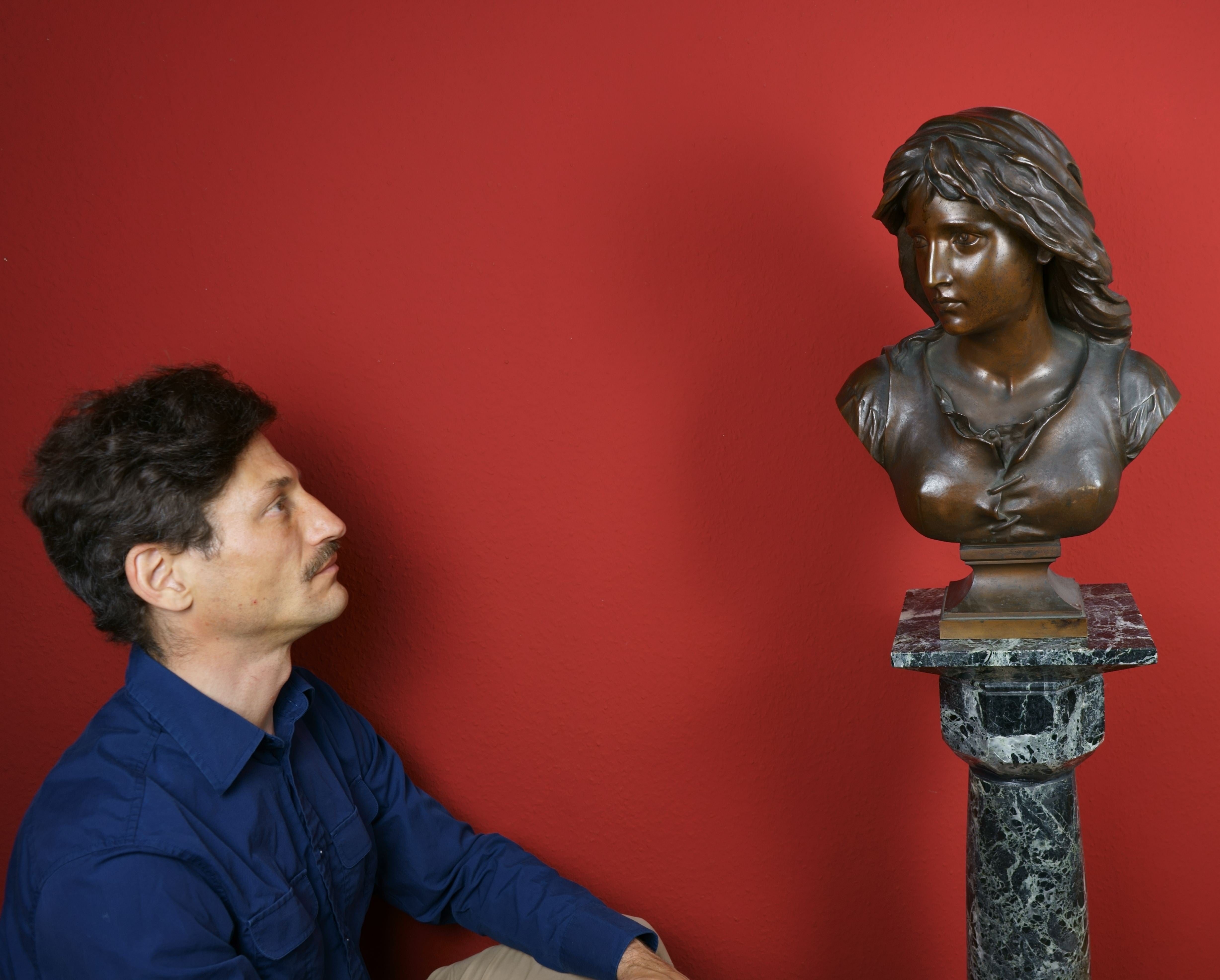
About the Seller
5.0
Vetted Professional Seller
Every seller passes strict standards for authenticity and reliability
Established in 2014
1stDibs seller since 2023
22 sales on 1stDibs
- ShippingRetrieving quote...Shipping from: Berlin, Germany
- Return Policy
Authenticity Guarantee
In the unlikely event there’s an issue with an item’s authenticity, contact us within 1 year for a full refund. DetailsMoney-Back Guarantee
If your item is not as described, is damaged in transit, or does not arrive, contact us within 7 days for a full refund. Details24-Hour Cancellation
You have a 24-hour grace period in which to reconsider your purchase, with no questions asked.Vetted Professional Sellers
Our world-class sellers must adhere to strict standards for service and quality, maintaining the integrity of our listings.Price-Match Guarantee
If you find that a seller listed the same item for a lower price elsewhere, we’ll match it.Trusted Global Delivery
Our best-in-class carrier network provides specialized shipping options worldwide, including custom delivery.More From This Seller
View AllReproachful
Located in Berlin, DE
Willibrord Haas (*1936 Schramberg), Reproachful, 2010. etching, 33.5 cm x 20 cm (plate size), 54 cm x 37.5 cm (sheet size). Signed “Willibrord Haas” in lead by the artist, dated “201...
Category
2010s Realist Nude Prints
Materials
Paper
Bust of a young woman / - Beauty of youth -
Located in Berlin, DE
Anonymous, Bust of a young woman, c. 1900, artificial marble and gray onyx marble. 37 cm (height) x 37 cm (width) x 22 cm (depth), weight 17.2 kg. Signed “GURRINI” on the reverse.
-...
Category
Early 1900s Realist Figurative Sculptures
Materials
Marble
$902 Sale Price
20% Off
Death as a servant / - Concise congeniality -
Located in Berlin, DE
Alfred Rethel after (1816 Diepenbenden - 1859 Düsseldorf), Death as a servant, around 1920. Color woodcut by Oskar Bangemann after a drawing by Rethel created around 1845 on handmade...
Category
1910s Realist Figurative Prints
Materials
Paper
Small Nude / - Abstract Figurativity -
Located in Berlin, DE
Gustl Stark (1917 Mainz - 2009 ibid.), Small Nude, 1946. Oil on canvas, marouflaged, 54 x 25 cm (picture), 30 x 60 cm (frame), signed "Stark" top left, verso twice signed "Gustav Stark", inscribed by hand as "Small Nude" and dated by hand "1946". With label of the exhibition of the Bundeshaus Bonn from 1956.
- Rubbed area in the lower third of the body, at the same level a retouch in the ochre background. I provisional frame.
- Abstract Figurativity -
About the artwork
During the war, Gustl Stark suffered a particularly severe blow for an artist: he lost his right arm. Nevertheless, he continued to devote himself to art, and the painting, created in 1946, immediately after the end of the Nazi reign of terror, testifies to the dawn of a new era. At the same time, the work is a rare example of the artist's early figurative work, as Stark turned entirely to abstract painting as early as 1950. And even this painting is by no means purely figurative; rather, it already illustrates Stark's turn toward abstraction.
We see a female nude, but one that remains faceless. This can be read symbolically and in relation to the immediate past epoch, which, in the face of horrors, silences and blinds - literally renders faceless. In this sense, the figure is positioned to 'look back'. But she does not look. While this meaning may resonate and make the painting an important work of the immediate postwar period, Gustl Stark is primarily concerned with something else here, namely art itself. The absence of the face leads to the body becoming something flat. Due to the de-individualization, we do not see a concrete person with his individual features, but a body surface. And indeed, the body is constructed through an extremely planar design. Even the contour lines that form the corporeality have a planar rather than a linear character, especially where they merge into shadow zones of almost the same color. And the surfaces themselves are not modeled. The incarnate parts do not show any plastic gradations; the corporeality is completely withdrawn into the plane, which is also true for the hair. In addition, there is no uniform background against which the figure could appear; rather, the area next to the hair is kept bluish, creating a succession of earth-toned colored areas, which again binds the figure to the surface.
Last but not least, the flatness is also forced by the painting technique. Gustl Stark paints directly, a la prima, onto the coarse canvas, whereby the structure of the painting support remains visible in the picture, and in places - around the hair, for example - the canvas itself can be seen. This structural all-over lends the picture a certain flatness.
Gustl Stark thus uses the very motif that stands for the corporeality of art par excellence - the female nude - to transform the spatiality of the traditional picture into a flatness characteristic of modern art. And yet, a strong impression of corporeality is created, without being produced by a painterly modeling of the body. The oscillation between flatness and corporeality creates the intense tension of this groundbreaking painting.
In Gustl Stark's oeuvre, as a consequence of the abstraction we see here, the figurative is completely stripped away in a further step, which is also a loss when looking at this early key work.
About the artist
Gustl Stark was the son of a woodcarver and, after an apprenticeship as a decorative painter, attended the State School of Arts and Crafts in Mainz from 1936 to 1937. Although he was severely wounded in the war and lost his right arm, he studied at the Würzburg School of Painting and Drawing from 1943-1944 and then at the Academy of Fine Arts in Nuremberg from 1944-1948.
He won a state scholarship at the state art competition in Bad Ischl. Numerous study trips to Sylt, Paris, Switzerland, Austria, Italy, Holland and Belgium followed.
Gustl Stark worked in Mainz and was the first artist there to focus on abstract painting. His work quickly gained international recognition, including the Salon Réaliés Nouvelles in Paris.
From 1963-1970 he taught at the State University Institute for Art and Work Education in Mainz and from 1970-1975 at the Johannes Gutenberg University. Gustl Stark became particularly famous for his color embossed prints, for which he invented his own technique.
Gustl Stark received numerous awards for his work. He received the Art Prize for Painting of the City of Mainz in 1962, the State Prize of Rhineland-Palatinate in 1984, and the Gutenberg Bust of the City of Mainz in 1987.
Selected Bibliography
Hans Vollmer (Hrsg.): Allgemeines Lexikon der bildenden Künstler des XX. Jahrhunderts, Vierter Band, Leipzig 1958, S. 344.
Hans H...
Category
1940s Realist Nude Paintings
Materials
Canvas
$2,658 Sale Price
20% Off
Access
Located in Berlin, DE
Willibrord Haas (*1936 Schramberg), Access, 1979. etching, 40 cm x 30 cm (plate size), 54 cm x 37.5 cm (sheet size). Signed “Willibrord Haas” in pencil by the artist, dated “1979”, t...
Category
1970s Realist Nude Prints
Materials
Paper
Untitled / - The archaism of nature -
Located in Berlin, DE
Jorge Machold (1940 Chemnitz - 2015 Berlin), Untitled, 1973. Color etching, 41.5 x 29.2 cm (plate size), 49.5 cm x 39.5 cm (sheet size), signed lower right in lead “J.[orge] Machold”...
Category
1970s Abstract Abstract Prints
Materials
Paper
You May Also Like
Madonna
Located in Wien, Wien
MUSEUM SCULPTURE
Master workshop
Hans Klocker
before 1474, possibly in Gais -
After 1500
"CRESCENT MOON"
Around 1480/90
Stone pine wood carved
Original version
Height 77 cm
This ext...
Category
15th Century and Earlier Figurative Sculptures
Materials
Wood
Price Upon Request
Our Lady of Mercy
Located in Mokena, IL
Our Lady of Mercy, 2021
Oil on Panel with Carved and Gilded Frame, 8 x 14 inches
A work of spiritual devotion, Justas Varpucanskis’s “Our Lady of...
Category
21st Century and Contemporary Renaissance Figurative Paintings
Materials
Gold Leaf
Madonna
Located in Wien, Wien
MADONNA
Il DE FRANCE/PARIS
Around 1270
Oak wood carved
Height 79cm
Category
15th Century and Earlier Figurative Sculptures
Materials
Oak
Price Upon Request
Conestabile Madonna Old Master Renaissance
By (after) Raphael (Raffaello Sanzio da Urbino)
Located in London, GB
After Raphael
Conestabile Madonna
1483 - 1520
Oil on poplar panel
Image size: 8 x 8 inches (20.5 x 20.5 cm)
Original ornate hand carved gilt frame
Conestabile Madonna
Made in compos...
Category
16th Century Old Masters Portrait Paintings
Materials
Canvas, Oil
Madonna Virgin 17th Century Sassoferrato Paint Oil on canvas Old master Italy
Located in Riva del Garda, IT
Giovanni Battista Salvi, known as Sassoferrato (Sassoferrato 1609 - Rome 1685) workshop/circle
Praying Madonna
Second half of the 17th century
Oil on canvas (57 x 46, with fr...
Category
17th Century Old Masters Paintings
Materials
Oil
$5,802 Sale Price
20% Off
Study for Assumption of the Virgin
Located in Middletown, NY
Graphite on hand made, fibrous wove paper, finished with gray wash. Unevenly trimmed sheet edges, non-archival tape remnants at all four corners, recto, well outside of image area. Horseshoe-shaped area of light discoloration that extends significantly into the figure's face, beneath the lips, and up over the rear of the head, dog-eared right lower corner with associated light discoloration at crease. DeMin and Belluno inscribed in graphite, verso.
A detailed study showing 'primo pensiero' for Giovanni DeMin's large scale fresco, Assumption of the Virgin...
Category
Mid-19th Century Old Masters Portrait Drawings and Watercolors
Materials
Handmade Paper, Graphite
More Ways To Browse
Mother Mary
Oval Picture
Painting On Porcelain
Kpm Plate
Kpm Plates Antique
Oil On Copper Painting 17th 18th
Carlo Dolci
Harley Quinn
Looney Tunes Background
Peter Samuels
Plaster Impronte
Superman The Animated Series Original Production Cel Supergirl
Bartolomeo Paoletti
Disney Background
Looney Bird
Original Comic Strip Art
Peanuts Art
Vintage Cat Hat
